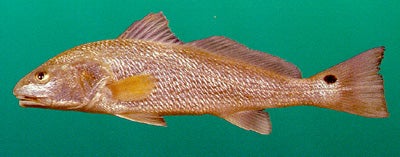SCIENTIFIC NAME:
Sciaenops ocellatus
CHARACTERISTICS:
The red drum, locally known as redfish, is distinguished by a prominent black spot at the base of the caudal fin and, rarely, a few smaller spots anteriorly. The predorsal region is not extremely elevated, as on other drum species. The head is conical in shape; the large, inferior mouth lacks barbells. Body color of this species varies from a pale to shiny silver in young individuals and to a brassy reddish or pinkish silver in older adults.
ADULT SIZE:
10 to 35 in (254 to 890 mm). Large adults may be 40 lb (18.1 kg). The state angling record ( 45 lb, 4 oz) was caught in August of 2007 near McDuffie Island at the mouth of the Mobile River, during an unusual drought period. The former record (43 lb) was caught in 1982.
DISTRIBUTION:
We encountered small rat reds in the Mobile Delta and in the Fish and Magnolia rivers in September and October. The distribution of this species in estuarine areas of Alabama is more extensive than indicated on the adjacent map; most of our collection efforts were confined to freshwater reaches of coastal streams.
HABITAT AND BIOLOGY:
Large red drum are found in the deep parts of estuaries and island passes, while young individuals frequent shallow areas near grass beds, jetties, and piers. A spawning migration occurs in late summer and fall toward shallow, open-water spawning grounds offshore. Foods of this species include crustaceans such as shrimp and crabs. Large schools of spawning adults were overharvested in the 1980s to satisfy a growing demand for blackened redfish. Fearing that brood stock levels could be adversely affected by uncontrolled harvest, marine fisheries biologists recommended strict seasonal and tonnage limitations along the Gulf Coast that have improved the population status of this desirable species.
REMARKS:
Smaller redfish in the 1-to-6-pound class provide a good seasonal sport fishery in the Mobile Delta and tributaries to Mobile Bay.
ORIGINAL DESCRIPTION:
Linnaeus described the red drum in 1766.
ETYMOLOGY:
Sciaenops means shade appearance.
Ocellatus means eye-like spots, referring to the caudal spots.
The copyrighted information above is from Fishes of Alabama and the Mobile Basin.






